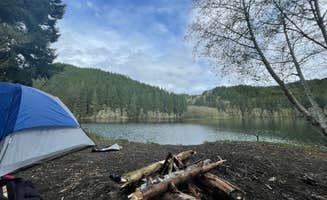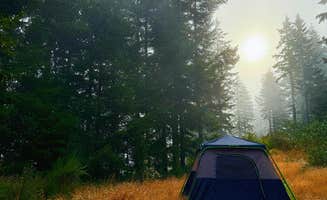Primitive camping near Yachats, Oregon offers opportunities throughout Siuslaw National Forest at elevations ranging from 300 to 1,200 feet. These no-facility campsites typically sit on gravel pull-offs along forest service roads that traverse the coastal mountain range. Winter camping requires preparation for temperatures that can drop below freezing, while summer brings moderate 60-80°F days with dense morning fog common through July.
What to do
Waterfall hiking: 4 miles round-trip. The Kentucky Falls Trail near BLM Kentucky Falls Road offers access to impressive dual waterfalls. "Great spot! Quiet and if you walk a little over through a trail you'll get an amazing view of the sunset," notes camper Desire R.
Wildlife observation: Dawn and dusk optimal. The areas around Beaver Creek are known for beaver sightings. A camper at Forest Road 51 mentioned: "Beaver creek area was really cool, but the main trail was flooded out when I visited. I did see about 5 beavers close to the road though, so that was sweet."
Night sky viewing: New moon periods best. The forest canopy at Hult Pond creates excellent dark sky viewing locations. "It was beautiful and quiet (other than the 9pm daily goose choir). The pond was great for kayaking and there is plenty to explore if you aren't worried about a little elevation in your hike," according to Nicki G.
What campers like
Forest isolation: Minimal weekend traffic. Dispersed sites along Forest Road 51 near Beaver Creek offer genuine seclusion. Gage reports, "Stayed here on a Sunday night in June, there's two campsites. One at the fork in the road and one slightly further down. Only had maybe 4 cars pass from 6pm to 10pm."
Strategic positioning: Last spots most private. Several campers recommend going past initial sites. Alicia W. advises: "Road is a bit overgrown in spots but if you go past the first 2 spots through the bushes last spot on the right is most private and spacious."
Established fire rings: Use existing pits. Many sites have fire rings from previous users. As Emily H. notes about Forest Road 51, "Last campers left pit and firewood - will leave some more for the next."
What you should know
Road conditions: Narrow passages. Many access roads have limited passing areas. One reviewer at Siuslaw National Forest Dispersed Camping cautions: "The way Google took us to this spot was terrible. Instead of keeping us on the gravel road, it had us drive through an overgrown dirt path. Thank got we didn't get stuck!"
Weather limitations: Avoid rainy periods. Most sites become difficult or dangerous to access in wet conditions. Connor G. warns: "Excellent spot up 2 steep inclines. Some of the most beautiful views. Good fire ring. Do not attempt if wet."
Communications blackout: No cell service. Most forest locations have zero connectivity. Grace A. cautions Hult Pond visitors: "We lost cell service about an hour before we even got there, and didn't have any the whole time there. There are some really cool spots that were taken."
Tips for camping with families
Safety considerations: Bring first aid supplies. The remoteness of these sites means emergency services are 30+ minutes away. In the Siuslaw National Forest, a camper observed: "It was dark, and I mean truly dark in there when you shut off your lights, and silent as a tomb."
Entertainment planning: Pack non-electronic options. Without cell service, families need offline activities. Chloe recommends: "About an hour from Corvallis but worth it if you can go at a good time! No service but great for seclusion! So remember all games and firewood you need!!"
Wildlife awareness: Store food properly. Corn Spur Road BLM and other remote sites attract wildlife. "Gorgeous views at the end of this road - no official spot but a lovely place to park for a night when campgrounds are full," notes Paige P.
Tips from RVers
Size restrictions: Small trailers only. Forest roads often can't accommodate larger RVs. Leo Y. warns about Forest Road 51: "Narrow and unpaved road. Very narrow, my trailer could barely fit through and there was only a three-way intersection inside to make a U-turn, otherwise my trailer wouldn't be able to get out!"
Turnaround planning: Scout ahead. RVers should identify turnaround points before committing to forest roads. Dillon & Soren A. share their experience at Hult Pond: "We have a 38 foot RV. We got stuck in a ditch. RV almost tipped over trying to u-turn... if you go down the main lower path you will find an area big enough to u-turn! Don't do it until then!"
Solar limitations: Heavy tree cover. Most sites have minimal sun exposure for solar setups. Kelda C. explains: "I found a pretty pulloff area, but quickly realized it's no good if you rely on cell service, solar and/or starlink due to the tree coverage."




